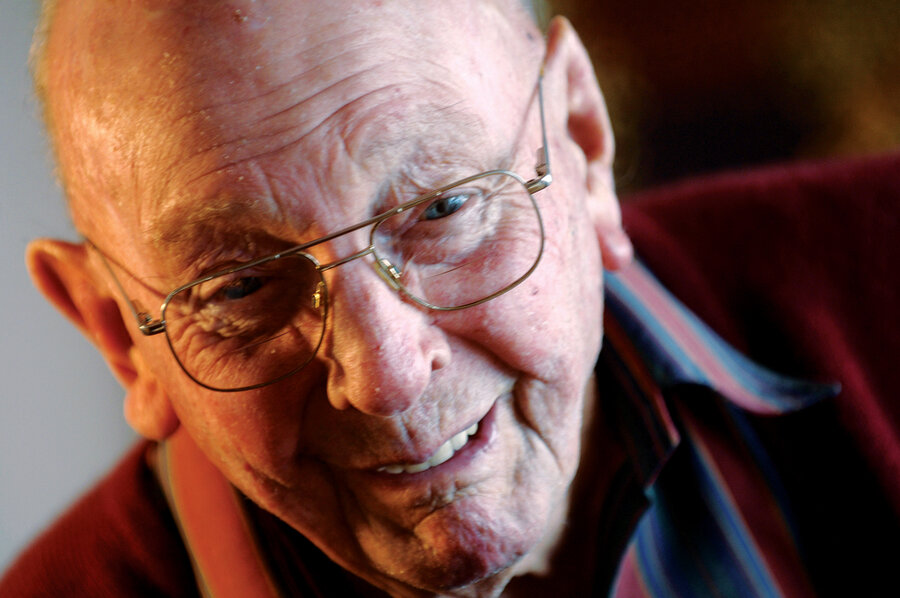He invites suicide jumpers for a cup of tea
Loading...
| Sydney, Australia
Don Ritchie bought his house for the beautiful views it affords of Sydney Harbor and "the Gap," the tall sandstone cliffs that guard the harbor mouth. Rather than simply admiring those views, though, he has spent the past 40 or so years persuading tortured souls not to jump to their deaths.
When he moved here with his wife, Moya, Mr. Ritchie was aware of the Gap's reputation as Australia's most notorious suicide spot. But he didn't think much about it.
Almost from Day 1, though, he found himself keeping an eye on the rugged cliff tops. Since then, he has coaxed hundreds of people back from the brink: the desperate, the depressed, and the mentally disturbed.
Ritchie, now an octogenarian, has been awarded a bravery medal and an Order of Australia, the country's second-highest honor.
To some, he's the "Angel of the Gap." It's an accolade that makes him smile with embarrassment. "Now I'm an old angel," he says during an interview at his home in Vaucluse, a suburb east of Sydney.
He and Moya live across the road from the Gap. Through the picture window in their living room, he has a bird's-eye view of the cliffs, which attract a steady flow of tourists and joggers. If he sees someone lingering a little too long, he crosses the road and offers them a cup of tea.
Over the years, many have followed him home. Others have not – his kind words have been the last thing they heard.
The self-effacing former salesman shrugs when you ask him why he does what he does. "I'm just trying to save a life," he says. "I used to sell kitchen scales and bacon cutters, then I was state manager of a life insurance company. At the Gap I'm trying to sell people life."
Australians have been committing suicide at this spot since at least 1863, when a local woman, Anne Harrison, leapt to her death. An estimated 50 people kill themselves there every year.
The municipal council wants to install taller, curved fences; emergency telephones; and closed-circuit TV cameras. But it needs $2.1 million (Australian; US$1.96 million) and the federal government has twice turned down its request for funds.
Over the decades, Ritchie says, many of the faces of the people he's saved have blurred. But some he still remembers clearly, such as the woman he spotted from his bedroom window early one morning, sitting right on the cliff's edge.
"I quickly got dressed and went over," he recalls. "She had already put her handbag and shoes outside the fence, which is pretty common. They very often leave something behind – sometimes it's a note, but generally a piece of clothing.
"I said to her: 'Why don't you come over and have a cup of tea?' She came with me, and Moya made her breakfast. When she got home, she rang to say she was feeling much better. Two or three months later, she walked up the garden path with a magnum of French champagne."
Dawn O'Neil, chief executive of Lifeline Australia, a counseling service for the suicidal and depressed, says the intervention of someone like Ritchie can be crucial when people are considering killing themselves.
"We know from research around the world that most people who are suicidal are ambivalent about dying," she says. "Most don't want to die; they just want to end their pain.
"So there's a hesitation, and anyone or anything that can distract them, or assist them to get help, can save their lives."
Gordon Parker, executive director of the Black Dog Institute, a clinical facility that treats people with depression, says: "People go to places like the Gap in a state of perturbation. They pace up and down, and in that period of time there's a window of opportunity. Don has saved lives because he has gone up to people and chatted to them."
Tragically, Ritchie's efforts are not always successful. He recalls a 19-year-old who jumped as Ritchie stood beside him. As he fell, his hat flew off, and the wind blew it into Ritchie's hand.
"It turned out that as a little boy he had lived in the block of flats just behind our house, and he used to play with our grandkids," Ritchie says. How did that make him feel? He removes his glasses and rubs his eyes. "It's just another case," he says.
In years past, Ritchie would scale the fence and sometimes physically drag people to safety. Once a woman nearly hauled him over the edge with her. He claims not to be troubled by those he couldn't rescue. "You can't do much about it," he says, turning his palms upward.
Dianne Gaddin, whose daughter, Tracy, committed suicide in 2005, says Ritchie may have been there for Tracy when she went up to the Gap on previous occasions. "Maybe he changed her mind those times," says Ms. Gaddin, who now campaigns for better suicide-prevention measures.
She is full of admiration for Ritchie's work. "It takes an enormous amount of courage just to go up to a person who is going to jump," she says.
"Don has a charisma about him. He makes people feel safe, secure, and calm. I really think he is one special man."
• For more stories about people making difference, go here.





